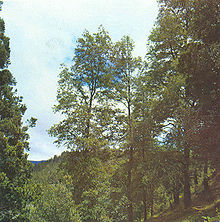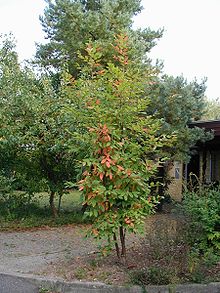- Nothofagus alpina
-
Nothofagus alpina 
Adult tree Conservation status Scientific classification Kingdom: Plantae (unranked): Angiosperms (unranked): Eudicots (unranked): Rosids Order: Fagales Family: Nothofagaceae Genus: Nothofagus Species: N. alpina Binomial name Nothofagus alpina
(Popp. & Endl.) Oerst.Synonyms N. procera
Nothofagus alpina (syn. Nothofagus procera) also called Rauli Beech is a species of plant in the Fagaceae family. Deciduous tree, it grows in Chile and Argentina , it reaches 50 m (160 ft) height and more than 2 meters (6.5 feet) in diameter. Its distribution goes from 35 to 42° South latitude. It is found on the Andes. It tolerates low temperatures and heavy winds. It has a straight and cylindrical trunk with grey bark.
Monoecious and leafy. Alternate leaves, peduncles in 3 to 12 mm long, oblong ovate to lanceolate ovate, with glands and hairs regularly distributed, undulate margins and softly serrated. Lamina in 4 to 12 x 2,5 to 5 cm, pinate veins, pilose and very notorious, mostly bellow the leaf, new borne twigs pubescent.
Flowers little unisexual: male in clusters of 3 flowers, briefly pedicelate, numerous stamens, male flowers disposed in 3 inflorescences supported by a peduncle in 1 cm long.
Fruit made up by a cupule of 4 narrow valves, in its interior 2 to 3 little yellowish nuts 6 mm long, a little hairy, being the two lower triangular, tri-winged, and the flat internal, bi-winged.
Rauli wood is pinkish with brown-reddish color and has a very fine grain. It is easy-to-work, and light heavy. It is used in furniture, barrels for very fine Chilean wines, doors, veneers, shingles and floors. It has been introduced as ornamental in Great Britain and it grows well in Western Scotland, where it gets the necessary rainfall for its good growth; minimum 750 mm (30 in). It is very promising as a forestry tree in Western Great Britain and regenerates easily after coppicing.[1]
Contents
Frost hardiness study in Britain
Provenance sources from different places from its natural environment were tested in cultivation at the Bush estate in Scotland. Seedlots of Nothofagus alpina and Nothofagus obliqua were tested. The results of the testing in relation to the sources were reported as:
- Nuble in Chile. This was the most equatorial source and these seedlots proved to be the most susceptible to frost.
- Neuquen in Argentina. These seedlots, as well as those gathered from mature trees growing in Britain with origins from Malleco in Chile were the most hardy. Overall, Nothofagus procera performed better than Nothofagus obliqua.
Past temperature records for Britain suggest that seedlots run a high risk of suffering severe frost damage in all but mild coastal regions, and that spring and autumn frosts may be more damaging than winter frosts.[2][3]
Other locations
At Nautesund in Norway[4] where the extreme minimum annual temperature is -14°C, combined with a south-facing exposure, good rainfall, and shelter from polar winds allow specimens of Rauli to grow.
References and external links
- ^ Huxley. A. 1992 The New RHS Dictionary of Gardening. MacMillan Press 1992 ISBN 0-333-47494-5
- ^ M. B. Murray, M. G. R. Cannell, L. J. Sheppard and R. Lines. 1986. Frost Hardiness of Nothofagus procera (alpina) and Nothofagus obliqua in Britain. Institute of Terrestrial Ecology, Bush Estate Penicuik, Midlothian, Scotland. Forestry Commission, Northern Research Station, Roslin, Midlothian, Scotland.
- ^ "Frost Hardiness of Nothofagus procera and Nothofagus obliqua in Britain". Oxford Journals. http://forestry.oxfordjournals.org/cgi/content/abstract/59/2/209. Retrieved 2010-03-19.
- ^ "Rauli in Norway". GIT Forestry Consulting. http://www.git-forestry.com/EucalyptusInScandinavia.htm. Retrieved 2009-06-27.
- Donoso, C. 2005. Árboles nativos de Chile. Guía de reconocimiento. Edición 4. Marisa Cuneo Ediciones, Valdivia, Chile. 136p.
- Hoffmann, Adriana. 1998. Flora Silvestre de Chile, Zona Central. Edición 4. Fundación Claudio Gay, Santiago. 254p.
- Rodríguez, R. & Quezada, M. 2003. Fagaceae. En C. Marticorena y R. Rodríguez [eds.], Flora de Chile Vol. 2(2), pp 64–76. Universidad de Concepción, Concepción.
- Bean. W. 1981 Trees and Shrubs Hardy in Great Britain. Vol 1 - 4 and Supplement. Murray.
- González, M. 1998. Nothofagus alpina. 2006 IUCN Red List of Threatened Species. Downloaded on 22 August 2007.
External links
- Rauli in Encyclopedia of Chilean Flora
- Rauli in Chile bosque
- Rauli, Description and images from Chile Flora
Australasia N. baumanniae • N. cunninghamii • N. discoidea • N. fusca • N. gunnii • N. menziesii • N. moorei • N. nuda • N. solandri • N. stylosa • N. truncata • N. womersleyiSouth America N. alessandri • N. alpina • N. antarctica • N. betuloides • N. dombeyi • N. glauca • N. nitida • N. obliqua • N. pumilioCategories:- IUCN Red List near threatened species
- Nothofagaceae
- Flora of Argentina
- Flora of central Chile
- Trees of Chile
- Trees of Argentina
- Garden plants of South America
- Ornamental trees
- Trees of mild maritime climate
- Near threatened plants
Wikimedia Foundation. 2010.


